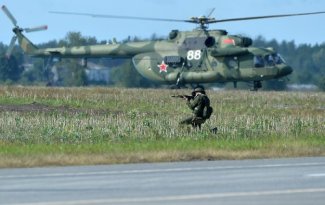The Zapad-2017 exercises: the information war (for now)

The Russian-Belarusian Zapad-2017 (West-2017) exercises, scheduled for 14–20 September, have for many months been the core of an information war between Russia and NATO, in which Ukraine and Belarus have also participated. The media have presented these exercises as allegedly the biggest military undertaking carried out in recent years by the armed forces of the Russian Federation (together with its Belarusian ally) in the immediate vicinity of the borders of NATO states, which could form the basis for the annexation of Belarus and/or a strike at Ukraine. And although it is hard to dispute the scale and breadth of these exercises, they are only a small part of Russia’s preparation for a potential military showdown with NATO. The real engagement of troops in these exercises will not be the largest, in terms of the scale and the force employed, or the most important in the Russian army’s preparation to carry out its plans during wartime in (from its perspective) the western strategic direction. The training exercises reported in the media, which have mainly been carried out on Russian training grounds from May to August this year, have not been an essential element of these preparations in 2017. These exercises, held jointly with the Belarusian component (in operational terms the Belarusian army should be considered as an integral part of the Russian armed forces in the western strategic direction), were nominally merely a preparatory stage to the Zapad-2017 exercises. The exercises involving Russian troops alone should be considered as more important, especially those checking the combat readiness of the units which have been newly created or expanded in the last three years. Compared to the period in which the previous exercises (Zapad-2013) were held, Russia’s military potential in the western strategic direction, especially its land forces, has doubled in size.
Zapad-2017 as a tool of information war
Russia treats the Zapad strategic exercises, which have been held every four years since 2009, as part of its information war with the West each time. However, whereas between 2009 and 2013 the propaganda impact of the reports about the exercises was largely local, limited mainly to the three Baltic states and Poland, as a result of the Russian aggression towards Ukraine and the three years and counting of war in the Donbas in 2017, it has now become one of the main factors affecting the relations of Russia with all the North Atlantic Alliance, as well as those Baltic Sea states which do not belong to NATO. Since the beginning Russia has treated the preparations for the Zapad-2017 exercises, on the one hand, as part of its intimidation of the general public in the countries directly bordering Belarus and Russia, through reports transmitted mainly through Belarusian or Ukrainian media. On the other hand, by gradually the deprecating reports about the scale and nature of the military threat (which have mainly been disseminated via Belarusian or Ukrainian media), it has been deepening the divisions between the ‘new’ and ‘old’ members of the European Union, on a wave of alleged anti-Russian hysteria generated by the former. Most likely in response to the Russian propaganda machine, the Zapad-2017 exercises have been used for the first time as an essential element in the information policy of NATO (and the United States), and also (in the regional dimension) by Ukraine. Unlike previous Zapad exercises, it is the message from Kiev which should currently be considered the most alarmist, and (thanks to the tension in Russo-American relations) it is being legitimised to a great degree by the North Atlantic Alliance.
The Zapad-2017 exercises are the core of the information war between Russia and NATO which has been going on uninterrupted since November 2016, when the plans of the Russian Federation’s Defence Ministry regarding an increase in military railway transports between Russia and Belarus in 2017 were disclosed. The number of 4162 cars contracted for the period from 1 January to 30 November 2017 (a figure several times larger than in previous years) was reported in the media as enabling a possible attack on Belarus by up to 30,000 soldiers, i.e. almost the entire Russian 1st Guards Tank Army. The consequence of this was a series of reports over the next few months stating that after the end of the exercises, the Russian group would remain in Belarus as occupation forces. Such reporting gained particular intensity in the first quarter of this year, when once again the government in Minsk simulated a more intense desire for rapprochement with the West – a move which suggests that this also was an element of Belarus’s own information war. Then comments appeared (particularly in the Ukrainian media) suggesting that the Russian soldiers transported to Belarus would be used to strike at Ukraine. It was only in August, on a wave of studies (emerging from Poland, among others) justifying the possibility of such a scenario, that Russia issued reports and figures indicating that the actual figure for the use of rolling stock in the Russian-Belarusian military exercises applied to the whole of the year 2017, and not just the Zapad-2017 exercises[1].
Russian representatives also began to supply data on the number of forces and vehicles planned for involvement in the exercises, including 12,700 soldiers (7200 from Belarus and 5500 from Russia, about 3000 of whom will be based in Belarus), 70 aircraft and helicopters, 680 armoured fighting vehicles (including 250 tanks), 200 artillery units (barrel, missile and mortar) and 10 ships[2]. These numbers are much lower than those cited in the previous media reports, especially those coming out of Ukraine. According to the National Security and Defence Council of Ukraine, the entire Zapad-2017 exercises were to have included 230–240,000 soldiers, over 10,000 units of heavy weapons, 100 aircraft and helicopters, and 40 ships[3]. Reports such as these should be considered as an attempt to mobilise Western (particularly American) support for Ukraine (especially in the area of defence).
The official Russian data should be considered as being far closer to the real figures, although they have been deliberately reduced to less than 13,000 soldiers, the ceiling figure which would have required the implementation of confidence- and security-building measures, including the mechanisms for observation exercises provided for in the OSCE’s Vienna Document. This has been backed up not only by the Russian army’s practice up to now, but above all by the conditions, starting with the capacity of the training grounds designated for the exercises in Belarus (4 general military grounds and 2 for air training) and Russia (3 in the Kaliningrad, Leningrad and Pskov oblasts). Nevertheless, the total number of forces and resources involved in the Russian and Russian-Belarusian training projects in the western strategic direction since spring 2017 may be up to ten times greater than those involved in the Zapad-2017 exercises.
Russian training activity in the western strategic direction in 2017
The Zapad-2017 exercises are the culmination of a series of training projects carried out in the western strategic direction in 2017. From the perspective of Minsk, they will be the biggest military event since the Zapad-2013 exercises, although from the perspective of Moscow, Zapad-2017 is just another project involving the forces and vehicles of the Western Military District, which from the training perspective are neither the biggest nor the most important of their kind. Starting in spring this year, the training grounds in Belarus and the Western Military District of the RF have seen at least several dozen projects in the field of mobilisation and combat readiness, redeployments, troop regrouping and advances, tactical exercises on training grounds etc., involving formations of all types of troops and services, from a minimum of battalion level up to and including division level. To better evaluate the scale of these projects, it should be noted that the training projects in the Zapad-2017 exercises will mostly be carried out at battalion level, up to brigade level.
In terms of the exercises to be carried out jointly with the Belarusian army, special attention should be paid to the projects based on support and security for the general military formations, the scale of which exceeds the requirements to prepare the subunits for the Zapad-2017 exercises. On 19–25 May, Belarus saw the largest ever exercises by electronic warfare units, which involved a total of 1500 soldiers from both armies. The logistical exercises carried out on 21–25 August, one element of which was a security operation for the pipelines supplying fuel to the frontline troops, should be seen in a similar light. These exercises proceeded on two different tracks, one as a Russian-Belarusian project (2500 soldiers from both countries on the territory of Belarus) and the other as purely Russian (3000 soldiers on the territory of the Russian Federation, which also included interoperability training in wartime with the transmission network operators). Of the projects preparing for Zapad-2017 carried out on the territory of Belarus, attention should also be paid to the training for engineering (13–15 June), communications (10–14 July), chemical defence (21–25 August) and air defence formations, in which aircraft from bases in Russia were moved to Belarusian airfields (23–25 August).
The summer training period for various kinds of exercise (which started in June) included the majority of the units in the Russian Federation’s Western Military District; this means that the formations comprising units for the Zapad-2017 exercises have effectively been in a state of permanent training. This principally concerns the Airborne Troops; the Baltic Fleet, together with its subordinate air-land grouping in the Kaliningrad oblast; and the 1st Guards Tank Army. It is also worth noting the two bilateral regimental exercises (in July, the 98th Airborne Division from Ivanov, with the participation of the 31st Air Assault Brigade from Ulyanovsk, at the training ground near Pskov; and in August, the 76th Air Assault Division from Pskov, with the participation of the above-mentioned 31st LAB and the 45th Spetsnaz Brigade), in both cases involving 2500 soldiers, at least 300 units of heavy weapons and several dozen planes and helicopters. During the Zapad-2017 exercises we can expect a much lower involvement of the airborne troops, at the level of tactical battalion groups.
Of the projects for the 11th Army Corps in the Kaliningrad oblast, attention should be paid to the brigade exercises of the 336th Naval Infantry Brigade from Baltiysk (in June) and the regimental exercises of the 7th Mechanised Regiment from Kaliningrad (in August), as well as the exercises by the 244th Artillery Brigade and the 25th Missile Brigade (nominally a coastal defence unit, armed with Bastion systems capable of destroying ground targets with Kalibr missiles). It must be stressed, however, that most of the maritime, land and air units which have been deployed in Kaliningrad have been training since June, and the 11th Army Corps has already held exercises four times (including twice in August). The units of the 1st Guards Tank Army, especially its two main tactical formations, the 2nd ‘Tamanskaya’ Mechanised Division and the 4th ‘Kantemirovskaya’ Armoured Division, should also be regarded as active. The tank crews of the 4th AD have also undergone some exercises in Belarus, conducted in mid-June. The most important elements of the 1st Guards Tank Army’s training, however, took place in August: checking the combat readiness of the tactical formations and the support and security units of the 1st Army (achieving combat readiness and preparation for deployment, 15 August) as well as the new automated command and control system (from 28 August).
Probably the largest tactical exercise carried out in 2017 in the Western Military District involved not the units assigned to participate in the Zapad-2017 exercises, but rather the mechanised divisions formed as part of the newly created 20th Army – the 3rd and the 144th MDs. On 14–18 August, a bilateral exercise was carried out at the training ground in the Voronezh oblast, including both the above-mentioned tactical formations (the participating units simulated a clash of opposing forces), in which 2000 soldiers and 600 units of heavy weapons took part. In the training projects which will make up the Zapad-2017 exercises, we should not expect any simulated clashes between formations of more than 1000 soldiers. In addition to those mentioned, we should note what will probably turn out to be the biggest Russian air defence exercises this year, which were carried out in the Western Military District at the beginning of July (5000 soldiers and 2000 units of arms and military equipment, including 100 aircraft and helicopters), as well as exercises by the Railway Troops in building crossings (on 1 August, they constructed a bridge 400 m in length across the Oka River; and on 24 August, a 1-km-long bridge on the Volga; for comparison, the crossing built on the Dnieper by engineering units in the context of the exercises in Belarus was 300 m in length).
The growth of Russia’s military potential in the western strategic direction
In the period between the Zapad-2013 and Zapad-2017 exercises, the Russian groupings in the western strategic direction changed diametrically. In all types of troops and services, the potential for growth has mainly been achieved through extensive large-scale technical modernisation, although in the case of the Land Forces, and to an extent the Airborne Troops, the most important factor was the formation of new units and the expansion of those already existing. It is noteworthy that the Western Military District is hosting most of the tactical formations which have been newly created in recent years, and those created in the other military districts have also been deployed in the western strategic direction (in the Rostov oblast, as part of the Southern Military District) or just beyond the Urals as part of the second strategic echelon in the western direction (in the Central Military District). Meanwhile, no new tactical formations have been created in the Russian Far East.
During the period in question, two new army headquarters have been created (the 1st Guards Tank Army in Moscow and the 8th Army in Novocherkassk), as well as three army corps (the 11th in Kaliningrad, the 14th on the Kola peninsula, and the 32nd in Crimea). The 8th Army and the 32nd Corps (both directed towards Ukraine) have received most of the newly created units. New divisions have also been deployed in the 20th Army (Voronezh). In total, between 2015 and 2017 four new divisions have been created (three mechanised: the 3rd, 144th and 150th MDs in the western strategic direction, in the Western and Southern Military Districts; and one armoured: the 90th AD in the Central Military District). The Russian army’s tactical formations are being systematically expanded up to wartime status; the newly-created divisions each have four regiments of combat potential which are comparable to brigades (which have the same structures and sizes of general military subunits), and additional regiments have also been created in the previously existing 2nd MD and 4th AD of the 1st Guards Tank Army. The creation of new military formations has been accompanied by the formation of brigades and regiments to provide support and security at army level.
The nature and structure of the airborne troops have also been changed; at present they are de facto mechanised formations with increased capacity for rapid redeployment, with a destructive force comparable to the classic mechanised formations (especially after the divisions and brigades of air assault tank companies, and ultimately of tank battalions, are included). The newly created reconnaissance brigades, which combine various elements including electronic surveillance, should be associated with the western military direction (so far only the Eastern Military District has not received any such units). As of June this year, thirty battalion and company tactical groups from Western Military District units had the status of immediate response forces. Fifteen of them have also received the status of so-called shock subunits.
The technical modernisation of the western strategic direction is proceeding at a rate comparable with that observed in the other strategic directions, although the process is distinct from those others in several ways. Units in European Russia have been the main recipients of new command and communications systems and electronic warfare equipment, as well as Ratnik personal equipment for the ‘soldier of the future’; they are also the first to have received the elements of the integrated command structure, together with equipment for tactical data exchange for ranks up to and including private (with the Ratnik equipment). The western strategic direction is also getting the majority of the new or modernised arms of the Land Forces (including T-72B3 tanks, which since their upgrade now have the same battle potential as T-90 tanks), as well as Su-34 battlefield support aircraft (frontline bombers) and Mi-28 attack helicopters.
As of mid-2017, the proportion of new and modernised weaponry in units in the Western Military District was 45%; therefore, we should see the rate of modernisation observed as guaranteeing that the planned ceiling of 70% will be achieved by 2020. In the first half of 2017 the Western Military District received 500 units of offensive heavy weapons[4], and another 500 units should reach those groupings in the second half of the year.
We should assume that the Western Military District will be the first recipient of the new generations of weapons, including T-14 tanks on the Armata platform (the Armed Forces of the Russian Federation have ordered 100 tanks of this type, to be delivered by 2020; at present one test company has been equipped with sixteen T-14 tanks) and Su-57 fifth-generation multi-role combat aircraft (T-50 PAK FA).
It is noteworthy that the rearmament of units in the Kaliningrad region is proceeding at relatively the slowest pace in the western strategic direction. On the one hand this can be seen as a political demonstration (for example, the rearmament of the 152nd Missile Brigade with the Iskander system is still being treated as an element of gameplay with the United States, i.e. as a ‘response’ to the deployment in Poland of elements of the American missile defence system); on the other, it represents a rational assessment of the military situation in the region (increasing the range of destructive weaponry, mainly by introducing Kalibr rockets, allows the Russian army to achieve any aim it wishes in the area of Central Europe without the need to use the infrastructure in the Kaliningrad region, which is potentially the most vulnerable to destruction by the local forces of NATO states).
Conclusions
Russia’s use of the Zapad-2017 exercises as the starting point for a military operation – the occupation of Belarus, a strike at Ukraine or even blocking the Suwalki Gap (which the exercises’ political scenario, disclosed on 29 August, might suggest[5]), and the possible amputation of the three Baltic states from the rest of the NATO area – should be considered as extremely unlikely. Undertaking such an action, along the model of 2008 (the attack on Georgia after the Kavkaz-2008 exercises), would mean that Moscow had acknowledged as essential the military necessity to counter the actual (or even formal) integration of Ukraine with Western structures, or the presence of the US military in that country (or in the Baltic states to any significant degree). Carrying out such an operation would be accompanied by non-military measures: in the first place, a massive information campaign to discredit the potential enemy, which as a result would justify the use of military force – at least to the Russian public. On the other hand, the condition for such an operation would have to be Moscow’s relative certainty that there would be no real combat response from the Western states and structures (especially the US and NATO). It should be assumed that in the present situation, the above-mentioned conditions for Russia to launch another military operation have not been met.
However, Russia’s actions in the military sphere over recent years indicate that its preparations for a possible armed conflict in Europe are being carried out consistently, and are permanent in nature. The armed forces of the Russian Federation have reached a level of ability that would allow the relatively smooth implementation of any military operation in the area of the former Soviet Union (albeit in the case of the three Baltic states, only upon the assumption of the effective disinterest of the US, which currently must be considered unlikely). It remains unclear whether Russia could implement its policy objectives by military means, which would in reality need Moscow to use its military factor. It must be assumed that, in the case of a maintenance of the status quo – i.e. the lack of any greater military support from NATO for Ukraine (of a kind which would actually influence the growth of the Ukrainian army’s potential), or the Alliance’s constant, significant military presence in the Baltic States – Russia would disregard the direct use of military force to implement its policy objectives at least until the end of the football World Cup, which it will host in June and July 2018; this event is treated in Moscow as a matter of high prestige. However, we should not expect the Russian Federation to cease or even limit its use of the military factor as a tool of its information war with the West.
Appendix. Changes in the numbers of expanded general military operational formations, tactical formations and units of the Land Forces of the Russian Federation in the western strategic direction between 2013–2017 (as of mid-2017).
|
|
2013 |
2014 |
2015 |
2016 |
2017 |
|
Armies |
2 |
2 |
2 |
3 |
4 |
|
Corps |
- |
- |
- |
2 |
3 |
|
Divisions |
2 |
2 |
2 |
3 |
5 |
|
Brigades/regiments[6] |
6/7 |
6/7 |
7/7 |
9/13 |
7/21 |
[1] See for example Владимир Сергеев, Эшелоны идут на «Запад-2017», http://belvpo.com/ru/8541.html
[2] Комментарий Департамента информации и печати МИД России относительно соблюдения в подготовки ходе учениям к транспарентности мер «Запад-2017», http://www.mid.ru/ru/foreign_policy/news/-/asset_publisher/cKNonkJE02Bw/content/id/2845944. It is noteworthy that previously – as the first to do so – the Russian defence ministry reported about 280 units of heavy weapons (combat vehicles and artillery) and 25 aircraft; we should assume that the data is consistent with the later report by the Russian foreign ministry, and that it applies only to the Russian army’s equipment which was planned for deployment in Belarus.
[3] О. Турчинов: «Запад-2017»-реальність і загрози, http://www.rnbo.gov.ua/news/2858.html.
[4] According to the Treaty on Conventional Armed Forces in Europe (CFE), tanks, combat armoured vehicles, artillery guns of 100-mm calibre and above, combat aircraft and combat helicopters.
[5] The report by the Russia Deputy Defence Minister, Aleksandr Fomin, deserves attention for its reference to the participation in Zapad-2017 by units of the FSB and the National Guard, which hitherto had been standard practice only in internal Russian exercises. The participation of groups from outside the Defence Ministry confirms that the exercises also include scenarios for possible pacification (occupation) after the attack by operating forces, and that the National Guard is preparing for tasks which in Soviet times had been performed by the troops of the NKVD.
[6] In the armoured and mechanised brigades and regiments of the Land Forces of the Russian Federation, the number and structure of the general military subunits (mechanised battalions or tank battalions) is identical.
Photo credit: Viktor Tolochko/Sputnik/East News





